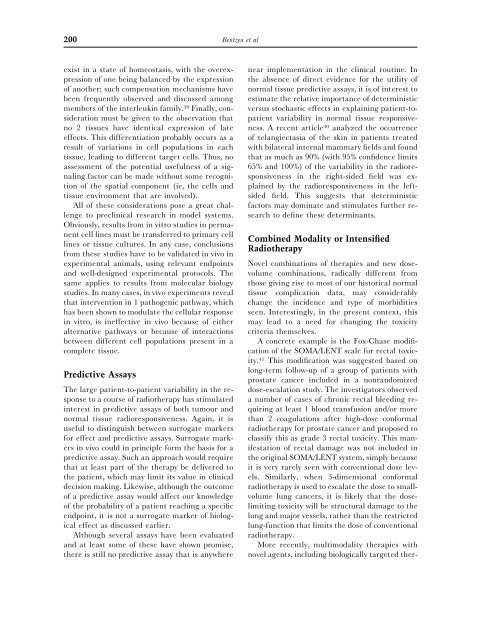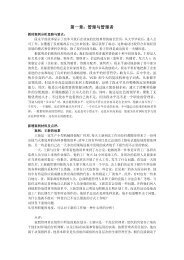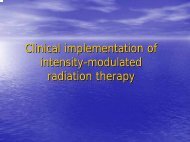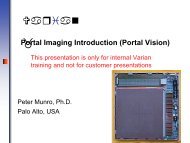Normal Tissue Effects: Reporting and Analysis
Normal Tissue Effects: Reporting and Analysis
Normal Tissue Effects: Reporting and Analysis
Create successful ePaper yourself
Turn your PDF publications into a flip-book with our unique Google optimized e-Paper software.
200 Bentzen et al<br />
exist in a state of homeostasis, with the overexpression<br />
of one being balanced by the expression<br />
of another; such compensation mechanisms have<br />
been frequently observed <strong>and</strong> discussed among<br />
members of the interleukin family. 39 Finally, consideration<br />
must be given to the observation that<br />
no 2 tissues have identical expression of late<br />
effects. This differentiation probably occurs as a<br />
result of variations in cell populations in each<br />
tissue, leading to different target cells. Thus, no<br />
assessment of the potential usefulness of a signaling<br />
factor can be made without some recognition<br />
of the spatial component (ie, the cells <strong>and</strong><br />
tissue environment that are involved).<br />
All of these considerations pose a great challenge<br />
to preclinical research in model systems.<br />
Obviously, results from in vitro studies in permanent<br />
cell lines must be transferred to primary cell<br />
lines or tissue cultures. In any case, conclusions<br />
from these studies have to be validated in vivo in<br />
experimental animals, using relevant endpoints<br />
<strong>and</strong> well-designed experimental protocols. The<br />
same applies to results from molecular biology<br />
studies. In many cases, in vivo experiments reveal<br />
that intervention in 1 pathogenic pathway, which<br />
has been shown to modulate the cellular response<br />
in vitro, is ineffective in vivo because of either<br />
alternative pathways or because of interactions<br />
between different cell populations present in a<br />
complete tissue.<br />
Predictive Assays<br />
The large patient-to-patient variability in the response<br />
to a course of radiotherapy has stimulated<br />
interest in predictive assays of both tumour <strong>and</strong><br />
normal tissue radioresponsiveness. Again, it is<br />
useful to distinguish between surrogate markers<br />
for effect <strong>and</strong> predictive assays. Surrogate markers<br />
in vivo could in principle form the basis for a<br />
predictive assay. Such an approach would require<br />
that at least part of the therapy be delivered to<br />
the patient, which may limit its value in clinical<br />
decision making. Likewise, although the outcome<br />
of a predictive assay would affect our knowledge<br />
of the probability of a patient reaching a specific<br />
endpoint, it is not a surrogate marker of biological<br />
effect as discussed earlier.<br />
Although several assays have been evaluated<br />
<strong>and</strong> at least some of these have shown promise,<br />
there is still no predictive assay that is anywhere<br />
near implementation in the clinical routine. In<br />
the absence of direct evidence for the utility of<br />
normal tissue predictive assays, it is of interest to<br />
estimate the relative importance of deterministic<br />
versus stochastic effects in explaining patient-topatient<br />
variability in normal tissue responsiveness.<br />
A recent article 40 analyzed the occurrence<br />
of telangiectasia of the skin in patients treated<br />
with bilateral internal mammary fields <strong>and</strong> found<br />
that as much as 90% (with 95% confidence limits<br />
65% <strong>and</strong> 100%) of the variability in the radioresponsiveness<br />
in the right-sided field was explained<br />
by the radioresponsiveness in the leftsided<br />
field. This suggests that deterministic<br />
factors may dominate <strong>and</strong> stimulates further research<br />
to define these determinants.<br />
Combined Modality or Intensified<br />
Radiotherapy<br />
Novel combinations of therapies <strong>and</strong> new dosevolume<br />
combinations, radically different from<br />
those giving rise to most of our historical normal<br />
tissue complication data, may considerably<br />
change the incidence <strong>and</strong> type of morbidities<br />
seen. Interestingly, in the present context, this<br />
may lead to a need for changing the toxicity<br />
criteria themselves.<br />
A concrete example is the Fox-Chase modification<br />
of the SOMA/LENT scale for rectal toxicity.<br />
41 This modification was suggested based on<br />
long-term follow-up of a group of patients with<br />
prostate cancer included in a nonr<strong>and</strong>omized<br />
dose-escalation study. The investigators observed<br />
a number of cases of chronic rectal bleeding requiring<br />
at least 1 blood transfusion <strong>and</strong>/or more<br />
than 2 coagulations after high-dose conformal<br />
radiotherapy for prostate cancer <strong>and</strong> proposed to<br />
classify this as grade 3 rectal toxicity. This manifestation<br />
of rectal damage was not included in<br />
the original SOMA/LENT system, simply because<br />
it is very rarely seen with conventional dose levels.<br />
Similarly, when 3-dimensional conformal<br />
radiotherapy is used to escalate the dose to smallvolume<br />
lung cancers, it is likely that the doselimiting<br />
toxicity will be structural damage to the<br />
lung <strong>and</strong> major vessels, rather than the restricted<br />
lung-function that limits the dose of conventional<br />
radiotherapy.<br />
More recently, multimodality therapies with<br />
novel agents, including biologically targeted ther-
















